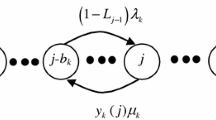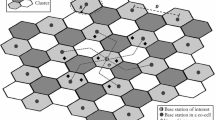Abstract
A CDMA uplink system that carries both voice and data traffic is investigated. The reservation-based admission control scheme is used to prioritize voice mobiles, and the truncated channel inversion power control scheme is used by data mobiles to improve system capacity. The performance of the system is measured by the Erlang capacity. Two methods of determining the Erlang capacity are presented. The first method decouples the analysis of blocking and outage performance, thus simplifying numerical search. The second method takes into account the impact of mobile traffic fluctuations on interference statistics, and thus yields more accurate results. Numerical results are provided that show significant differences between the two methods. Finally, the Erlang capacities of the system are compared for different power control schemes.
Similar content being viewed by others
REFERENCES
J. M. Jacobsmeyer, “Congestion relief on power-controlled CDMA networks,” IEEE Journal On Selected Areas In Communications, vol. 14, pp. 1758–1761, December 1996.
F. Adachi, M. Sawahashi, and H. Suda, “Wideband DS-CDMA for next-generation mobile communications systems,” IEEE Communications Magazine, vol. 36, no. 9, pp. 56–69, September 1998.
E. Dahlman, P. Beming, J. Knutsson, et al., “WCDMA-the radio interface for future mobile multimedia communications,” IEEE Transactions on Vehicular Technology, vol. 47, no. 4, pp. 1105–1118, November 1998.
L. Ding and J. S. Lehnert, “Performance analysis of an uplink power control using truncated channel inversion for data traffic in a cellular CDMA system,” in Proc. IEEE Vehicular Technology Conference (an extended version was submitted to IEEE Transactions on Vehicular Technology), May 2000.
K. S. Gilhousen, I. M. Jacobs, R. Padovani, A. J. Viterbi, Jr., L. A. Weaver, and C. E. Wheatley, III, “On the capacity of a cellular CDMA system,” IEEE Transactions on Vehicular Technology, vol. 40, no. 2, pp. 303–312, May 1991.
M. Gudmundsom, “Correlation model for shadow fading in mobile radio systems,” IEEE Communications Letters, vol. 27, no. 23, pp. 2145–2146, November 1991.
Author information
Authors and Affiliations
Rights and permissions
About this article
Cite this article
Ding, L., Lehnert, J.S. Erlang Capacity of a Voice/Data Cellular CDMA Uplink System Using Prioritized Admission Control and Adaptive Power Control. International Journal of Wireless Information Networks 8, 1–14 (2001). https://doi.org/10.1023/A:1011363928080
Issue Date:
DOI: https://doi.org/10.1023/A:1011363928080




